How to Make Sourdough Bread — This easy sourdough bread recipe uses yogurt and sour cream in place of a traditional sourdough starter, which makes it possible to prep a loaf in less than a day!
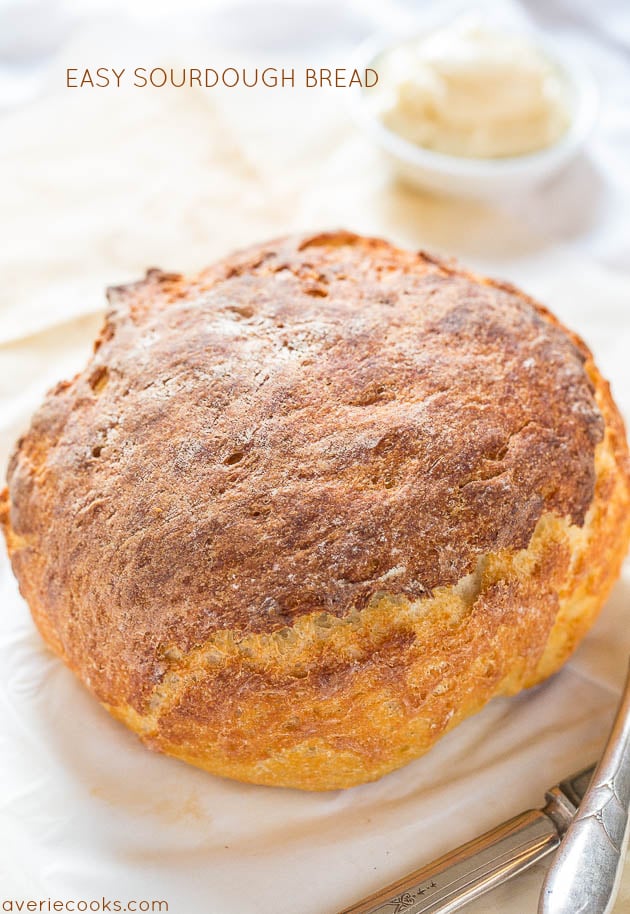
Table of Contents
- Easy Homemade Sourdough Bread Recipe
- Homemade Sourdough Bread Ingredients
- How to Make Sourdough Bread
- Do I Have to Use a Dutch Oven?
- Can I Freeze Sourdough Bread?
- Can I Make This Gluten Free?
- Tips for Making Sourdough Bread
- Easy Sourdough Bread Recipe
- Easy Sourdough Bread Recipe
- More Homemade Bread Recipes:
Easy Homemade Sourdough Bread Recipe
I’ve always wanted to make sourdough bread and can finally check it off my culinary bucket list. And rather than doing it in week(s), I did it in hours.
Traditional sourdough starters take 5-7+ days to develop and making the bread can take a full day, whereas I made this bread in 9 hours. Do it as an overnight recipe or think of it like a slow cooker recipe. Set it and forget it because it really is that easy.
Rather than using a traditional sourdough starter, Greek yogurt and sour cream are mixed with bread flour, yeast, and a pinch of salt. The active cultures in the Greek yogurt and sour cream ferment the dough and give the bread traditional sourdough flavor. The longer you let the bread rise and ferment, up to about 18 hours, the more sourdough-ey it’ll taste.
I’ve made the homemade sourdough bread twice because my family kept raving about this loaf. For this bread, I did a 6 1/2 hour rise/ferment (first rise) and for the next loaf I did 10 hours. The 10-hour version was more sourdough-ey and also had a more more ‘holey’ and open crumb, but I wouldn’t necessarily say the 10-hour was ‘better’. Both are fabulous.
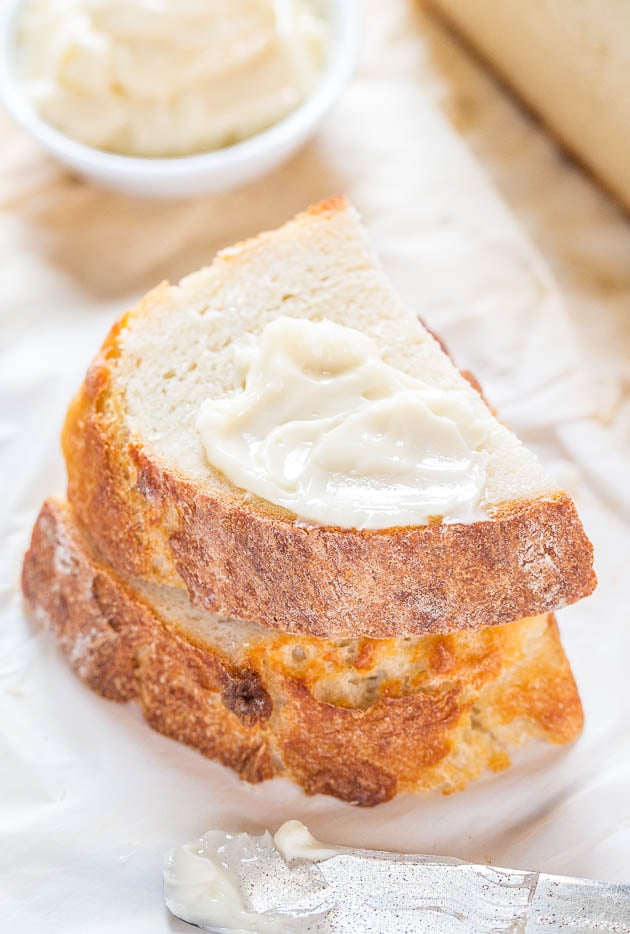
If you’ve ever made bread, this recipe will be a total snap. Much easier than cinnamon rolls, sweet rolls, or dinner rolls, by a long shot.
The bread is hearty, satisfying, and has a firm crust that gives was to a super moist, soft interior. My daughter loves crust (she didn’t get that from me) and my family devoured the loaf in one sitting.
I got the bug to try this because of Mandy’s post and without knowing I was making homemade sourdough bread or the flavor goal, my family said it tastes like a piece of San Francisco sourdough bread from a fancy bakery.
It’s so rewarding knowing I made bread that looks and tastes like something from a bakery. You’re going to love that feeling. And you’re going to love the bread.
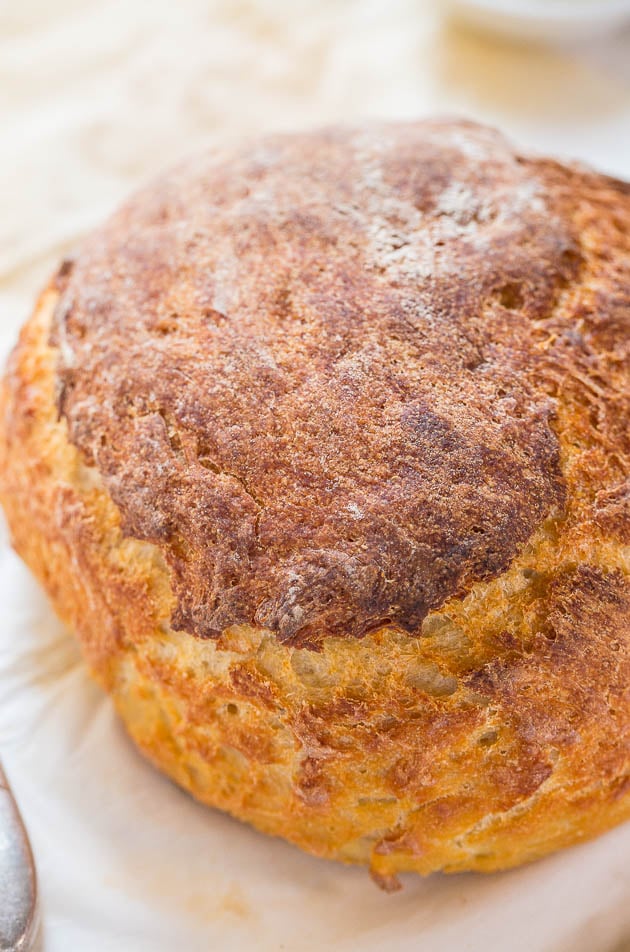
Homemade Sourdough Bread Ingredients
When making sourdough bread, you’ll need:
- Bread flour
- Plain Greek yogurt with live active cultures
- Sour cream
- Salt
- Instant dry yeast
How to Make Sourdough Bread
Add all the sourdough bread ingredients to the bowl of a stand mixer and knead the dough for 5 to 7 minutes using a dough hook attachment. The dough will be seem like it’s almost too wet and it’s very heavy, but this is what you want.
Place the dough in an oiled bowl, cover with plastic wrap, and let rise for 6 to 8 hours. Once risen, remove the dough from the bowl and gently knead for a couple minutes. Shape the dough into a round mound and put back into oiled bowl to rise for another 1 to 2 hours.
Preheat your oven and place an empty Dutch oven inside to preheat as well. Once the oven is preheated, carefully remove the Dutch oven, place parchment paper on the bottom, and place dough inside. Cover with a lid and bake, then uncover during the last 10 minutes of baking.

Do I Have to Use a Dutch Oven?
While it’s not imperative to bake the bread in Dutch oven, it really helps develop sourdough’s signature crusty crust because a covered Dutch oven traps in the steam the bread releases while baking, aiding in crust development. This is the exact Le Creuset Dutch oven I used.
If you don’t have a Dutch oven, a cast iron skillet or heavy-bottomed skillet will work, although some of the crustiness will be sacrificed.
Can I Freeze Sourdough Bread?
Yes, homemade sourdough bread freezes well. Let the baked bread cool completely before freezing (you can freeze the entire loaf or slice and freeze).
Can I Make This Gluten Free?
That is a question I am not sure about since I have not tried this recipe with gluten-free flours of any kind.
However, my gut tells me that I definitely don’t think almond flour or spelt flour will work. A baking flour that is a cup-or-cup style replacement of traditional all-purpose flour is the only flour I think has a flying chance, but I do not know if it will work.
I have only made the recipe exactly as written. If you make the recipe with gluten-free flour, please comment how it went for you.
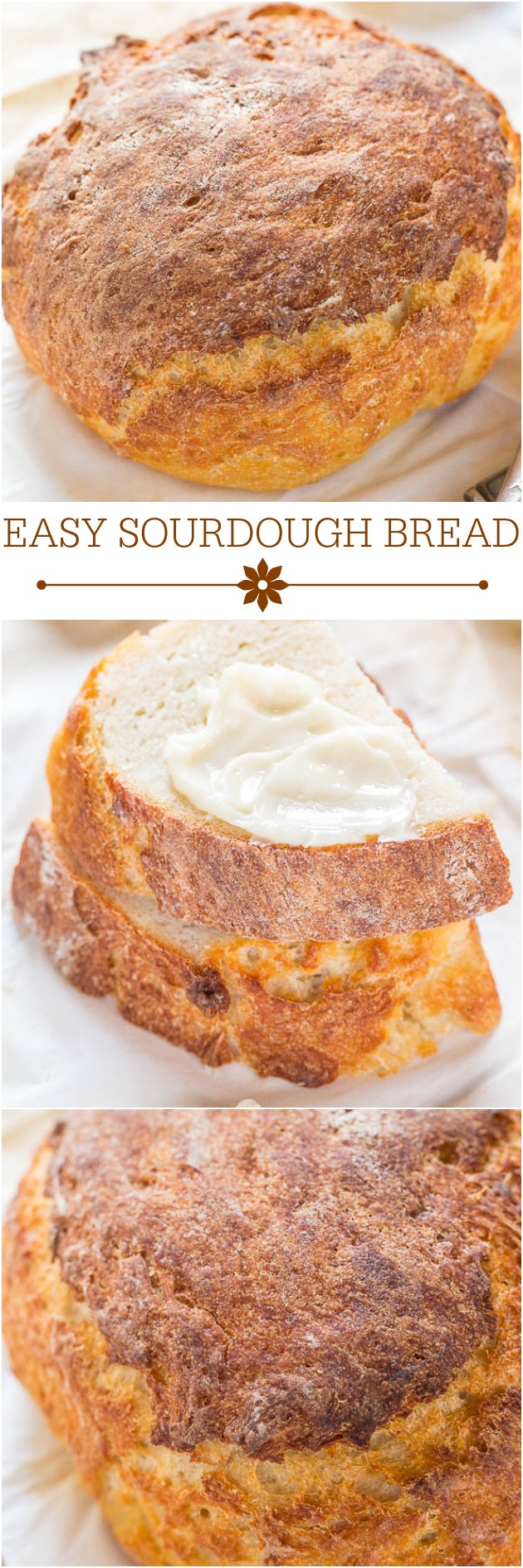
Tips for Making Sourdough Bread
I highly recommend using King Arthur bread flour for this sourdough bread recipe. I think it’s the best quality bread flour and it delivers consistently good results.
The sourdough bread recipe looks long but that’s because I write yeast recipes with as much detail and give as many tips as I possibly can to set you up for success. Read the recipe at least twice before starting. All you’re really doing is making dough, letting it rise for 6+ hours, letting it rise again for 1+ hour, and baking.
I like it served simply with honey butter or butter. Or try jam, jelly, or hummus. The bread is great toasted, perfect for sandwiches, for crostini, or with your favorite dip. I wouldn’t complain if you put a hunk of cheese and bread in one hand and a glass of wine in the other.

Pin This Recipe
Enjoy AverieCooks.com Without Ads! 🆕
Go Ad Free
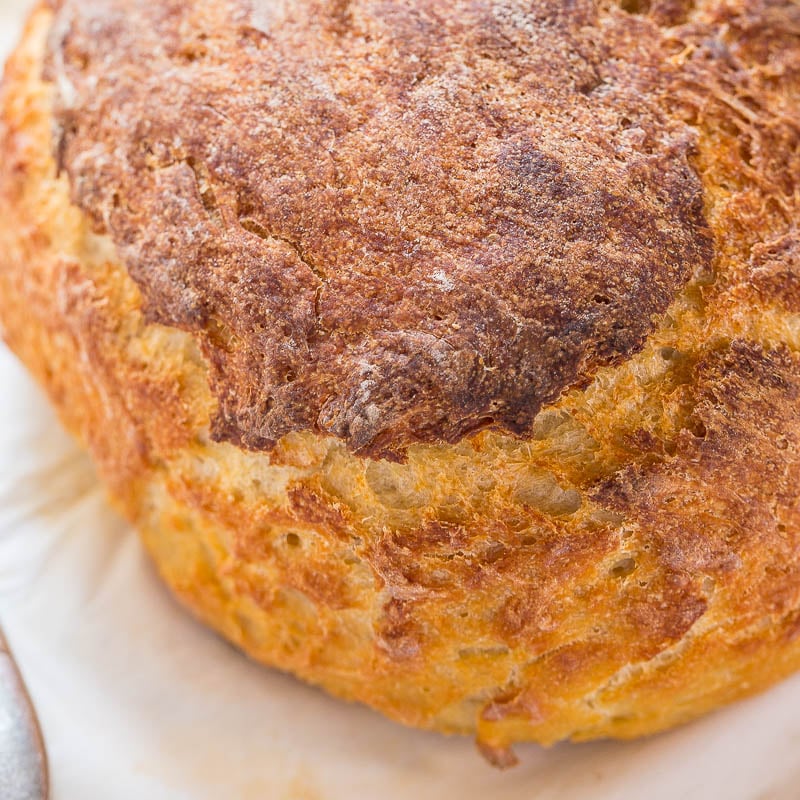
Easy Sourdough Bread
Ingredients
- 3 cups bread flour, I use King Arthur
- one-17.6 ounce tub plain unsweetened Greek yogurt with active cultures, 500 grams
- about 1/2 to 1 cup sour cream, or Greek yogurt, lite versions are okay
- 1 teaspoon salt, or to taste
- scant 1 teaspoon, just slightly less than 1 teaspoon instant dry yeast (I use Red Star Platinum)
Instructions
- To the bowl of a stand mixer fitted with the dough hook (or use a large mixing bowl and wooden spoon and your hands), add the flour, Greek yogurt, 1/2 cup sour cream, salt, and yeast.
- Turn mixer on low speed and allow it to knead dough for about 5 to 7 minutes (about 7 to 10 minutes by hand using a wooden spoon and then switching to your hands). Add sour cream as needed to form a very moist and wet dough. If it’s at all dry or crumbly, add more sour cream (or Greek yogurt) until it comes together. I used one-17.6 ounce tub of Greek yogurt and almost 1 cup lite sour cream. Dough will be seem like it’s almost too wet and it’s very heavy, but this is what you want. Err on the side of wetter than drier because flour and yeast love moisture when rising.
- Remove dough from the mixing bowl, spray a large bowl with cooking spray, pat dough into a round ball, place it in the bowl, and flip it over once so it’s lightly oiled on both top and bottom. It will look like a dimply head of cauliflower.
- Cover bowl with plasticwrap (spray it with cooking spray in case dough rises high enough to touch it) and place bowl in a warm, draft-free place to rise for about 6 to 8 hours (I did 6 1/2 hours), or doubled in size. If you want to start this before work or before bed and made as an overnight dough and it’ll go 8-10 hours, that’s fine. There’s really no harm in letting it rise for up to 18 hours and the longer you let it go, the more of a classic sourdough/fermented flavor that will develop. If you suspect you’re going to allow it to rise on the longer side (12-18 hours), reduce yeast to about 1/2 teaspoon so dough doesn’t get too puffy and overflow the bowl.
- After 6+ hours of rising, turn dough out onto a floured surface (without punching it down to preserve the air pockets and bubbles that have been created) and knead lightly for about 2 to 3 minutes.
Pat dough into a round mound, and place it back into large mixing bowl, seam side down. Cover with plastic wrap, and allow to rise for 60 to 120 minutes, or until doubled in size (I did 60 minutes; I suspect the longer you let the second rise go, the more ‘holey’ the bread will be). Placing the bowl on the stovetop is a nice spot for this rise because you’re going to turn on the oven and the residual heat emitted helps with rising. - Shortly after dough begins the 60-120 minute rising, turn oven on to 450F and place a covered 7 to 10-quart or sufficiently large Dutch oven (empty) or heavy-bottomed skillet into the oven and allow it to heat for about 45 minutes. Dutch ovens are so heavy and take so long to get truly hot, and when you’re ready to bake the bread, you want the Dutch oven screaming hot.
- After about 60-90 minutes or dough has doubled in size, remove Dutch oven from oven (careful, it’s screaming hot, use two pairs of hot mitts) and carefully place a piece of parchment paper on the bottom of Dutch oven to prevent bread from sticking.
Carefully transfer dough from rising bowl to Dutch oven, cover it, and bake covered for 30 minutes. Don’t open the oven door or the Dutch oven lid to peek; you want to seal in the steam. - After 30 minutes, uncover the Dutch oven, and allow bread to bake uncovered for 5 to 10 minutes (I did 8 minutes) or until it’s as browned as desired. Traditional sourdough has a darker crust than most bread (sometimes almost burnt-looking, but I prefer mine on the lighter side).
- Remove Dutch oven from oven, and remove bread from Dutch oven. Place it on a wire rack to cool completely before slicing. As tempting as it is, don’t slice too early because the cooling process is important and should be considered an important extension of the baking process. Slice or break off hunks, and serve with honey butter, butter, jam, hummus, etc.
- Bread is best fresh, but will keep airtight at room temp for up to 3 days. Older bread may be better toasted.
Notes
- Note that the yogurt you use must say ‘active cultures’, I used 0% Non-Fat Fage.
- Use closer to 1/2 teaspoon yeast if you plan to allow dough to rise for 12-18 hours; see step 4 above.
Nutrition
Nutrition information is automatically calculated, so should only be used as an approximation.
©averiecooks.com. Content and photographs are copyright protected. Sharing of this recipe is both encouraged and appreciated. Copying and/or pasting full recipes to any social media is strictly prohibited.
Pin This Recipe
Enjoy AverieCooks.com Without Ads! 🆕
Go Ad Free

Easy Sourdough Bread
Ingredients
- 3 cups bread flour, I use King Arthur
- one-17.6 ounce tub plain unsweetened Greek yogurt with active cultures, 500 grams
- about 1/2 to 1 cup sour cream, or Greek yogurt, lite versions are okay
- 1 teaspoon salt, or to taste
- scant 1 teaspoon, just slightly less than 1 teaspoon instant dry yeast (I use Red Star Platinum)
Instructions
- To the bowl of a stand mixer fitted with the dough hook (or use a large mixing bowl and wooden spoon and your hands), add the flour, Greek yogurt, 1/2 cup sour cream, salt, and yeast.
- Turn mixer on low speed and allow it to knead dough for about 5 to 7 minutes (about 7 to 10 minutes by hand using a wooden spoon and then switching to your hands). Add sour cream as needed to form a very moist and wet dough. If it’s at all dry or crumbly, add more sour cream (or Greek yogurt) until it comes together. I used one-17.6 ounce tub of Greek yogurt and almost 1 cup lite sour cream. Dough will be seem like it’s almost too wet and it’s very heavy, but this is what you want. Err on the side of wetter than drier because flour and yeast love moisture when rising.
- Remove dough from the mixing bowl, spray a large bowl with cooking spray, pat dough into a round ball, place it in the bowl, and flip it over once so it’s lightly oiled on both top and bottom. It will look like a dimply head of cauliflower.
- Cover bowl with plasticwrap (spray it with cooking spray in case dough rises high enough to touch it) and place bowl in a warm, draft-free place to rise for about 6 to 8 hours (I did 6 1/2 hours), or doubled in size. If you want to start this before work or before bed and made as an overnight dough and it’ll go 8-10 hours, that’s fine. There’s really no harm in letting it rise for up to 18 hours and the longer you let it go, the more of a classic sourdough/fermented flavor that will develop. If you suspect you’re going to allow it to rise on the longer side (12-18 hours), reduce yeast to about 1/2 teaspoon so dough doesn’t get too puffy and overflow the bowl.
- After 6+ hours of rising, turn dough out onto a floured surface (without punching it down to preserve the air pockets and bubbles that have been created) and knead lightly for about 2 to 3 minutes.
Pat dough into a round mound, and place it back into large mixing bowl, seam side down. Cover with plastic wrap, and allow to rise for 60 to 120 minutes, or until doubled in size (I did 60 minutes; I suspect the longer you let the second rise go, the more ‘holey’ the bread will be). Placing the bowl on the stovetop is a nice spot for this rise because you’re going to turn on the oven and the residual heat emitted helps with rising. - Shortly after dough begins the 60-120 minute rising, turn oven on to 450F and place a covered 7 to 10-quart or sufficiently large Dutch oven (empty) or heavy-bottomed skillet into the oven and allow it to heat for about 45 minutes. Dutch ovens are so heavy and take so long to get truly hot, and when you’re ready to bake the bread, you want the Dutch oven screaming hot.
- After about 60-90 minutes or dough has doubled in size, remove Dutch oven from oven (careful, it’s screaming hot, use two pairs of hot mitts) and carefully place a piece of parchment paper on the bottom of Dutch oven to prevent bread from sticking.
Carefully transfer dough from rising bowl to Dutch oven, cover it, and bake covered for 30 minutes. Don’t open the oven door or the Dutch oven lid to peek; you want to seal in the steam. - After 30 minutes, uncover the Dutch oven, and allow bread to bake uncovered for 5 to 10 minutes (I did 8 minutes) or until it’s as browned as desired. Traditional sourdough has a darker crust than most bread (sometimes almost burnt-looking, but I prefer mine on the lighter side).
- Remove Dutch oven from oven, and remove bread from Dutch oven. Place it on a wire rack to cool completely before slicing. As tempting as it is, don’t slice too early because the cooling process is important and should be considered an important extension of the baking process. Slice or break off hunks, and serve with honey butter, butter, jam, hummus, etc.
- Bread is best fresh, but will keep airtight at room temp for up to 3 days. Older bread may be better toasted.
Notes
- Note that the yogurt you use must say ‘active cultures’, I used 0% Non-Fat Fage.
- Use closer to 1/2 teaspoon yeast if you plan to allow dough to rise for 12-18 hours; see step 4 above.
Nutrition
Nutrition information is automatically calculated, so should only be used as an approximation.
©averiecooks.com. Content and photographs are copyright protected. Sharing of this recipe is both encouraged and appreciated. Copying and/or pasting full recipes to any social media is strictly prohibited.
More Homemade Bread Recipes:
Easy Cheddar Sourdough Bread — The bread is hearty, satisfying, and has a firm crust that gives was to a super moist, soft interior with ample hunks of cheddar.
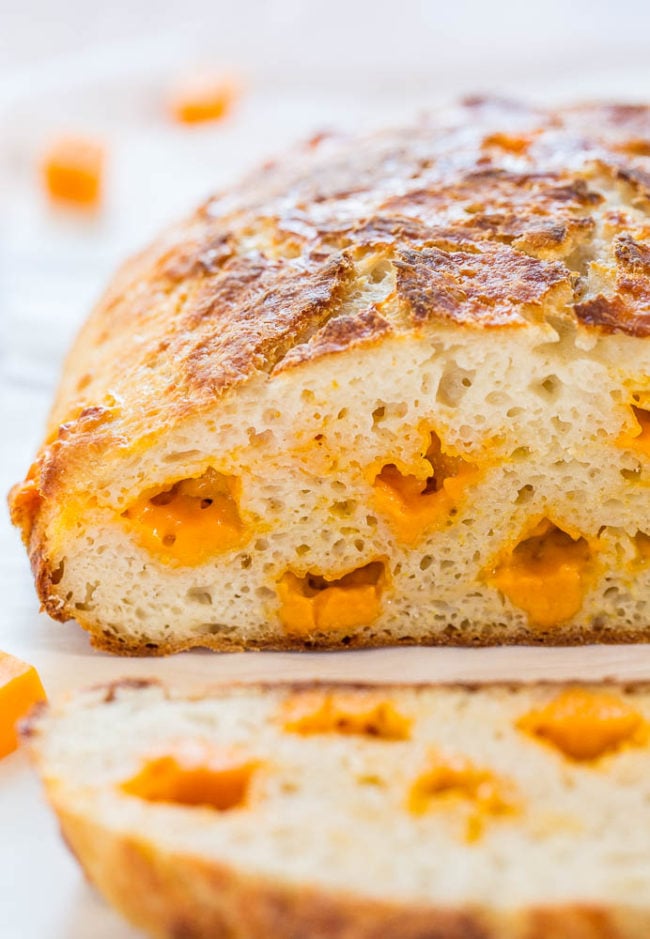
No-Knead Make-Ahead Dinner Rolls with Honey Butter — The easiest dinner rolls ever! No kneading, no fuss & you can make the dough ahead of time! Perfect for holiday meals and parties!
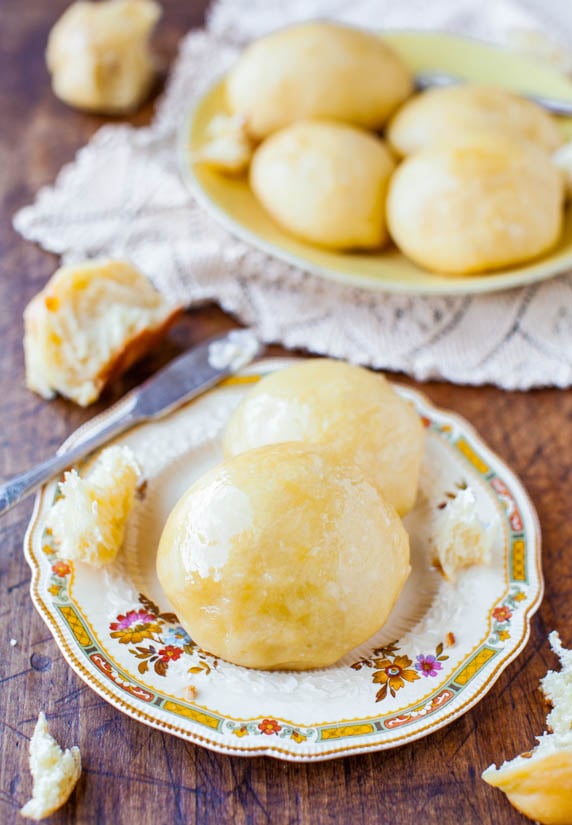
Raisin Bread for Raisin Lovers — There’s nothing worse than raisin bread with like five raisins in the whole slice, which isn’t a problem here. Calling all raisin lovers, this bread is for you!
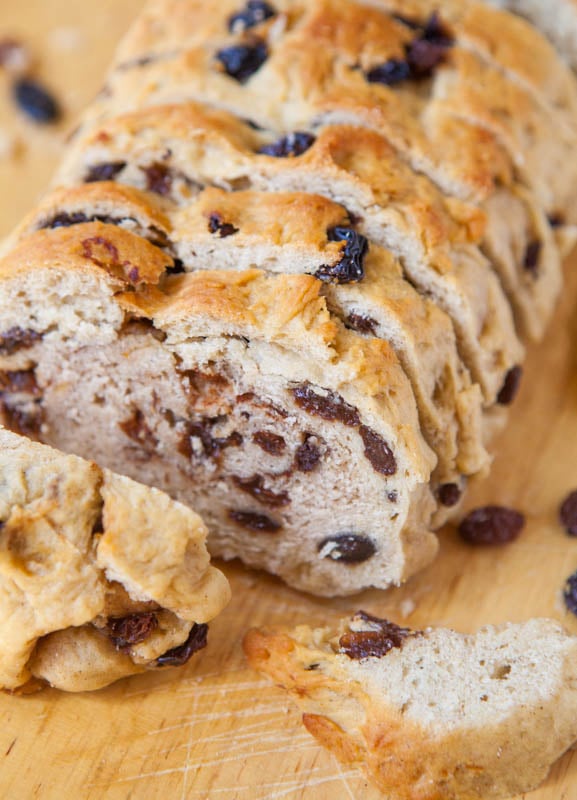
Honey Dinner Rolls — Soft, fluffy rolls brushed with sweet honey butter! Truly the best dinner rolls ever. They disappear so fast at holiday meals & parties!
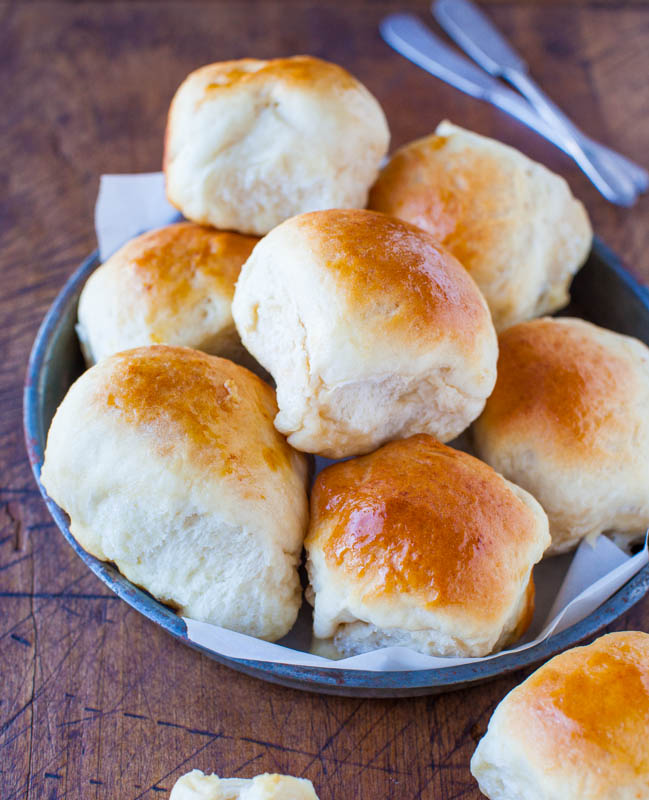
One-Hour Sun-Dried Tomato, Basil, and Mozzarella Focaccia Bread — The bread is soft and chewy, loaded with tangy sun-dried tomatoes, and the basil is the perfect complement to the tomatoes.
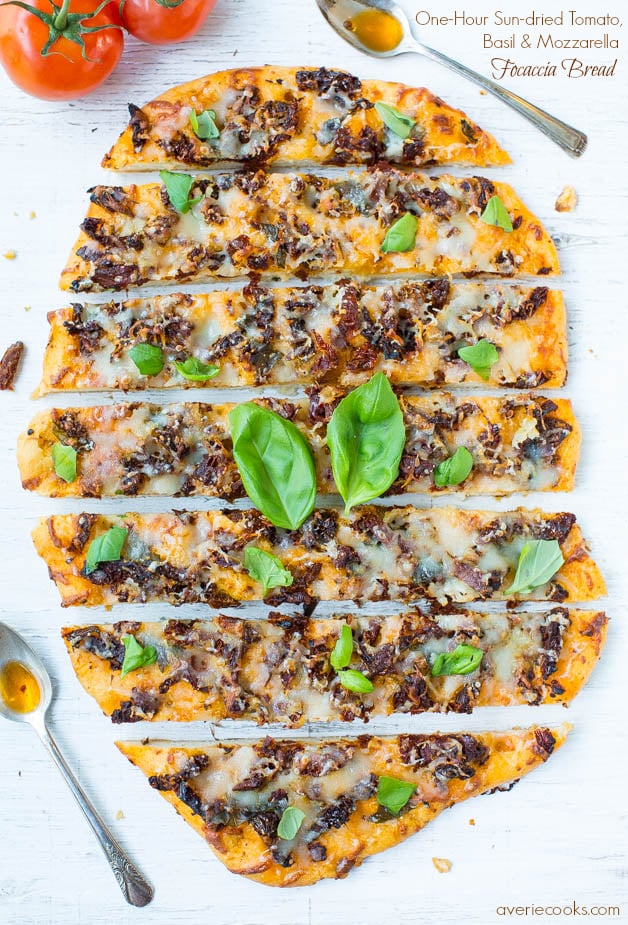
100% Whole Wheat No-Knead Make Ahead Dinner Rolls with Honey Butter – Working with wheat flour and yeast is usually the kiss of death but these rolls are light, fluffy, soft and you’d never guess made exclusively with whole wheat flour!
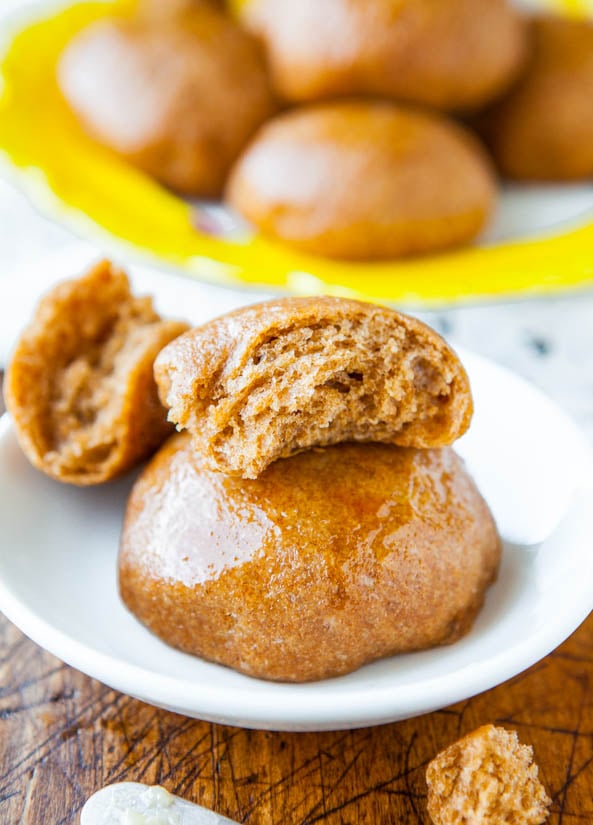
Soft and Fluffy Sandwich Bread (vegan) — The bread is versatile for anything from sandwiches to grilled cheese to French toast. It’s an easy recipe, even for bread-making novices.
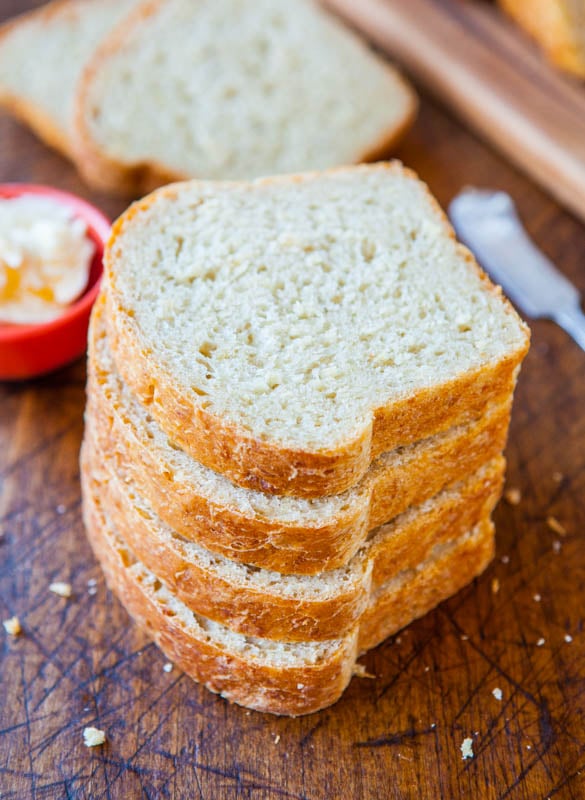
Originally posted November 20, 2014 and reposted with updated text February 25, 2022.
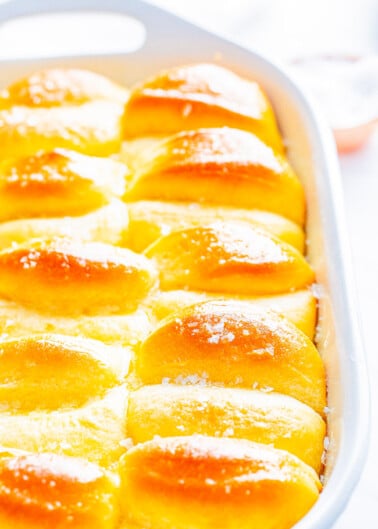
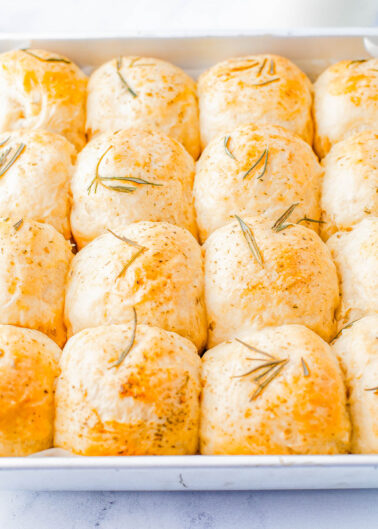
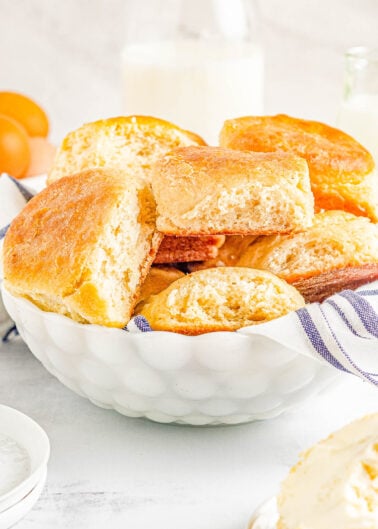
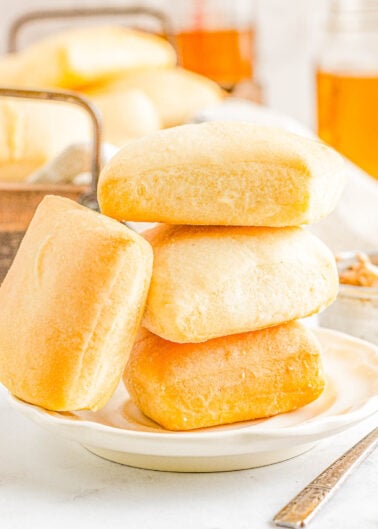
I followed your guidance; lowered the temp to 400 degrees & baked an additional 30 minutes, checking in 10 minute increments. Et voila! It was perfection. Additionally, I had located the Red Star Platinum yeast & what a great product. All 3 loaves, even the less than perfect loaf, were excellent but it was fun mastering this. Merci mille fois’
Glad my guidance worked and that it came out great for you! And yes, Red Star Platium is the bomb! I love that stuff; it’s like insurance for bread-making!
i baked my 2nd loaf using the proper flour, yeast & a new cast iron Dutch oven BUT the crust burned before the bread was fully cooked. Can you provide guidance? I’m thinking of using 400 degree oven next time but am open to other ideas. The taste was perfect but 1/3 of the loaf was undercooked.
Dutch ovens, cast iron pots, lids or no lids, the oven itself, the climate, the dough, etc…ALL of these things play a role and no one’s equipment and situation is going to be exactly alike so with bread, trial and error is often the best way. In this situation based on what you said, I think turning down the oven to 400F is a good idea and also maybe make your loaf a little ‘flatter’ and less like a big round globe. That will help it cook quicker and more evenly as well. Keep me posted how round 2 goes! Glad that 2/3 of round 1 tasted good :)
Success ! I really watched the dough and added slightly less than 1 cup of sour cream. I could tell from the dough consistency that it was going to work. It raised up just perfect and stayed that way! It was delicious. Only it never lasts more than one day at our house.
Thanks for trying the recipe and I’m glad you were able to tell from the dough consistency that it was going to work! Love it when as a bread maker you can see/feel a dough even in the very early stages and just know, yep this is a keeper! Love that feeling and glad you love the bread and that it lasts 1 day, max! :)
oops, I meant “substitutions” not “substations”!
This recipe is absolutely perfect! We recently retired to a rather remote location & are unable to buzz out to the store (especially with the snow) but I REALLY wanted to try this. I did NOT have sour cream or Red Star Platinum yeast & my King Arthur was the plain, unbleached variety of flour. I did have a big, beautiful tub of Grreek God full-fat yogurt.
I used my enamel lined Le Crueset Dutch oven & now plan to pick up a cast iron Dutch oven to use exclusively for sour dough bread. I will also pick up the King Arthur Bread flour & the Red Star Platinum yeast! My Le Cruset suffered a little in the preheating process but it was worth the sacrifice. I felt the substations were not too far off & I was right.
The sour taste was heavenly & the chewy crust with the soft, tender center were perfection. I apologize for preparing with substitutes but I have really wanted to make my own sour dough bread & loved your logical decision to use yogurt, brilliant.
Thanks for trying the recipe and I’m glad it came out great for you! And no apologies for substitutions! You totally winged it based on what you had (in a remote area, in a snowstorm!) and all worked out – gotta love that!
I use an enameled Le Creuset dutch oven with this bread too. And when I bake this bread in it, the dutch oven does get a few more brown spots on the ‘white’, which after 10-12 years of cooking with it, it’s not that bright enameled white anymore either so I’m just like…whatever. I think that you will love the Red Star Platinum and KA’s bread flour is just extra nice for bread since you get extra gluten for extra rise and puff. But sounds like you didn’t even need it! Glad it was a hit for you!
Helpful hint: put your dough on a piece of parchment paper, before putting in bowl for the second rise. Makes it easier to move the dough to the dutch oven.
The bread looks and tastes amazing. It was big and full when I removed it from the oven. But as it cooled on the rack, it started to deflate. I was wondering about how smooth the bread should be when kneading it, after it rises over night? Mine was still very tacky, and I added more flour while kneading. I followed the recipe and used 1 tsp of yeast. I found I had no parchment paper, and used a circle of foil instead. Could too much liquid be the culprit? I had the oven on at 450 degrees. The bread just looks like it is not quite cooked; the bubbles collapsed as it cooled.
Any suggestions?
Thanks for trying the recipe and I’m thinking that your idea of “The bread just looks like it is not quite cooked” is spot on – just cook it longer :) Being that all brands of yeast, greek yogurt and sour cream, climates, flour brand and gluten content variances, type of pan/pot used to bake it in, etc…. SO MANY things could vary that my advice to people is to bake until done, whatever that means in your oven and in your situation with your ingredients and not to worry about the clock so much.
Any baked good that falls or deflates, from cake to bread, generally means the internal temp was *not quite* hot enough to really set the structure of the item, and it will fall upon cooling.
And also if you think your dough was pretty darn moist (yes it’s an extremely moist dough) but…if you think there was too much liquid, and based on everything else, there probably was…counteract that with 1. more flour and/or 2. longer baking time.
You’re SO close….give it one my try and tweak things slightly & LMK how it goes!
I made this as a Boule and it is hot out of the oven…18 hr first rise, 3 hour second rise. I handled it as a no-knead bread, but used a stand mixer to knead as directed, etc.. Topped with Quinoa seeds before baking. It has a beautiful, shiny (but intermittent ) medium golden brown top crust and artisan brown bottom–just gorgeous. Internal temp at about 207 deg. F. when I gauged mine– baked throughout, for sure!
Take your time ladies, you can do it, too.
Love your comment and thank you for sharing everything you did and yes, taking one’s time, taking the internal temp or knowing approx what it was, all these little things do matter in bread-making and I’m so glad your boule turned out wonderfully! I love that you did a 18 + 3 hour rise and as a no-knead in terms of how you handled it. I bet the flavor was incredible and really authentic sour-doughey after your long rises! Thanks for the wonderful comment and trying the recipe!
I made your sourdough bread yesterday, wish I could post a picture it look beautiful from the outside but it had a big hollow spot on top..what did I do wrong…..please help me! I used full fat yogurt and sour cream don’t know if that was it but other than that I followed the recipe to the letter…. Also last night when I tasted it was sour, this morning not so much!!! Please help me my husband is a sourdough lover, but I’m not good with keeping up with normal starters…. Thanks Sandy
With bread-making there are SO many variables. What I think happened in this situation is that the bread rose very fast in the oven, created the hollow spot, then it was just…hollow. You could try turning your oven down 25 to 75 degrees and baking longer at a lower temp. That could help. I use Red Star Platinum yeast and have never had issues with that yeast acting finnicky so maybe switch brands of yeast to; just to anything NEW that you didn’t use and maybe that will self-correct things. Trial and error, that’s bread :)
As a sourdough baker myself, this really intrigues me. Starters are a real pain and baking sourdough bread is a lot of work. I only have one question. Do you think that using whole milk Greek yogurt and regular sour cream would work?
I don’t like using fat free or low fat because of the additives in them that are needed to get the same consistency as regular whole milk products.
I was concerned the increased fat in the whole milk yogurt and regular sour cream might affect the texture. Any thoughts?
Baking, especially bread, can be trial and error. I think you should use the ingredients with the particular fat percentage you’re interested in using and then see what happens. If it doesn’t work, then use what I did – I know it works :)
I have a baking FAQ post here that may help, too! https://www.averiecooks.com/faq
Looks like a great take on naturally leavened sourdough! I noticed you didn’t score the top of the loaf before baking, were you going for a more “rustic” look to your loaf?
Thanks for the recipe, I might try my somewhat experienced hand at it this coming week! Ciao :)
I really don’t ever score my bread. When I do, I feel like it doesn’t end up cosmetically looking the way I want, so I don’t do it.
This is amazing! I made the dough before bed last night and it is cooling now. This is the prettiest bread I have ever made. Perfectly browned and cracked on top. I wish is could attach a picture. I admit I already cut off a small slice while it is still warm. Delicious! Just like sourdough!
Oh I am so glad you love it and it came out perfectly for you!! My very next post on Wednesday is going to be for a spinoff version of this! Please check back :)
Oh bother. I tried this today and I totally screwed it up. The bread fell flat, it got burned on the bottom, and it was not all the way done on the inside. The burned bottom happened to me the last time I baked bread as well. Last time I used parchment, this time I oiled the pot. Any suggestions? I was thinking maybe putting the Dutch oven on top of a baking sheet or glass pan, so the heat doesn’t hit it so directly.
Oil = what you want to add to vegetables, popcorn, etc. in the bottom of a pn to make it become browned!
Oil + bread = guaranteed to burn. No where in the recipe did I say to oil the pan so that’s one issue and falling flat. I think your yeast could have been inactive OR the internal temp of the bread didn’t get hot enough (despite it burning on the bottom from the oil you decided to use) and so you need to still bake it longer but with no oil next time. I would just try again with your regular Dutch oven, no cooking sheets, pans, etc. Just the D.O. with parchment and I think you will be fine.
I have a question: I happened to see on my roll of parchment paper that it only withstands temperatures of 420. I see the bread needs to be bakes at 450. Did you have any problem with the parchment burning or getting kind of crispy? Should I oil the bottom of the Dutch oven instead of using parchment? Thanks!!
It was fine for me but do as you see fit. Obviously I don’t want to recommend anything that could start a fire! But I was fine :)
I don’t have a Dutch oven or an iron skillet. If baked in a loaf pan or on a sheet, would it not turn out very sourdough-ey? The skillet/oven is for the crust, no? Any ideas on improvising for that part?
Thanks
You never know til you try it! And I’m pretty sure if you read through the comments there are others who have written in discussing what they’ve done in your situation (just from my memory…so you may want to read through the comments).
I made this recipe today. I’m not sure if I did something wrong or not. But it fell completely flat and isn’t brown. I have a Dutch oven and the base is rated to 500 deg while the cover is only 350 deg so I covered the pot with foil. To lock in the steam. Any ideas? I really wanted this to work out and I’m willing to try again. :)
fell completely flat and isn’t brown = dead ringer for you didn’t bake it long enough. All Dutch ovens, ovens, yeast, dough, climates, etc are different. I suggest baking longer – til it’s brown. If the internal temp of bread doesn’t get hot enough, it will fall upon cooling and I think that’s what happened here. Try again, bake longer. I think you’ll be set!